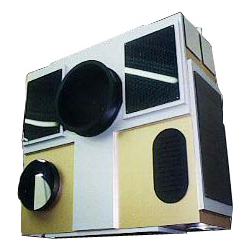
| ||||||||
| MOST | List of targets | SDS2 Archive |
Microvariability and Oscillations in STars (MOST)
 MOST is a Canadian space project dedicated to seismology of Sun-like and magnetic stars as well as to study microvariability in
Wolf-Rayet winds and many other targets.
MOST is a Canadian space project dedicated to seismology of Sun-like and magnetic stars as well as to study microvariability in
Wolf-Rayet winds and many other targets.
Payload:
This orbit allows to monitor certain program
stars in a Continuous Viewing Zone for up to 7 weeks without
interruption. The satellite will be stabilized by a set of miniature
reaction wheels which will point the telescope to an accuracy of about
10 arcsec. In order to reach the required photometric precision
Fabry microlenses (a few 100 microns across)
image the telescope pupil onto a CCD. This image will be spread
over about 40 x 40 pixels and will not be infected by the residual wobbles of the satellite, thus virtually eliminating photometric noise due to pixel-to-pixel sensitivity variations. Adjacent microlenses produce comparable images of the sky background an
d allow to correct for scattered Earth and zodiacal light.
The design goal for the photometric precision is better
than a few micromag for stars as faint as V = 6 mag and with an observing time of about ten days. To resolve the second-order splitting of eigenfrequency spectra of some target stars a longer time base might be necessary.
A 15-cm Maksutov telescope will be part of a microsatellite with 60 kg mass and a size of about 65 x 65 x 30 cm (like a small suitcase).
The microsat will be launched into a polar sun-synchronous orbit of about 800 km height in December 2002 as part of a multiple payload mission from Plesetsk, Russia, on an SS-19 based launch vehicle called Rockot.
Target Stars:
The target star list for the MOST mission includes objects of the following
groups:
- solar type stars,
- metal poor subdwarfs,
- rapidly oscillating Ap (roAp) stars,
- Wolf-Rayet stars,
- delta Scuti stars,
- lambda Bootis stars,
- pulsating SDB stars
- pre-main sequence stars
See also:
 Target inventory of MOST prime target fields
Target inventory of MOST prime target fields
Download a catalog of the MOST prime targets containig lists and starcharts of all interesting objects which can be found in an observable area around the prime target stars.
 The MOST Project at UBC
The MOST Project at UBC
The MOST Ground Station in Vienna
For the control of the spacecraft and the reception of the scientific data two Canadian ground stations in Vancouver (UBC) and Toronto (UTIAS) are planned. The third ground station will be located at the Institute for Astronomy of the University of Vienna
.
MOST will fly in a polar orbit and the downlink is only possible if the satellite is at least 15 degrees above the horizon of one of the ground stations in Vancouver or Toronto, which happens only for a couple of hours per day. During the time when MOST c
annot be reached from the ground the data have to be stored on-board for later transmission. The on-board memory is limited due to restricitions in mass, volume and power supply of the satellite which also restricts the amount of observed data to be downl
inked.
The Austrian ground station will be a copy of the two Canadian ground stations. The MOST ground station instrumentation is rather unexpensive compared to the complexity of satellite ground stations in general because it can use commercial amateur radio el
ectronics.
The ground station will consist of two directional antennas (2m dish
and long yagi) on an azimut-elevation mount under computer control to
follow the direction to the spacecraft within a few tenth of a degree.
Commercially available radio-amateur equipment will be modified to
serve as a transceiver for digital transmission on intermediate frequencies with Doppler shift compensation.
Some special built transverters and power amplifiers have to be provided
for the S-band frequencies allocated to space science.
High quality passband filtering will be required for reception and
transmission.
The baseline definitions for the data storage and downlink were calculated using only the two Canadian ground stations in Vancouver and Toronto. Substantial improvement can be achieved with the third 'Vienna' ground station.
Significance of the Vienna Ground Station:
By adding a third ground station, we make it possible to:
- send down better-resolved images of the target star and background fields, improving our ground-based data calibration; it would even be possible to download full spatial resolved Fabry images (64 x 64 pixels) in full time resolution.
- obtain data for more secondary target stars (including potential delta Scutis and Hipparcos microvariables of particular interest to the Vienna group) and perform highly resolved time series photometry for them (~50% more than by just working with 2
ground stations)
- remove artifacts and background drifts from the data
- make it more efficient to repoint the telescope and lock onto a new target, since it will be possible to send commands and receive responses more often
- improve the response time to onboard problems, improving the scientific efficiency, particularly early in the mission during the engineering and "shake-down" phases
- improve communication with the satellite because of the different geographical location of Vienna compared to Vancouver and Toronto
We are grateful to build the MOST ground station in collaboration with a team from the Institut für Nachrichtentechnik und Hochfrequenztechnik of the Technical University, Vienna.
See also:
 MOST - Vienna Groundstation
MOST - Vienna Groundstation
Last Update: 11.03.2002
In charge of this page is: Konstanze Zwintz

